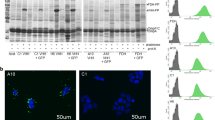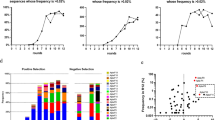Abstract
Lymphocyte origin hybridoma Ped-2E9 cell-based cytotoxicity assay can detect virulent Listeria or Bacillus species, and its application in a cell-based biosensor for onsite use would be very attractive. However, maintaining enough viable cells on a sensor platform for a prolonged duration is a challenging task. In this study, key factors affecting the survival and growth of Ped-2E9 cells under modified conditions were investigated. When the Ped-2E9 cells were grown in media containing 5% fetal bovine serum in sealed tubes without any replenishment of nutrients or exogenous CO2 supply, a large portion of the cells remained viable for 6 to 7 days and cells entered into G0/G1 resting phase. The media pH change was negligible and no cell death was observed in the first 4 days, then cells sequentially underwent apoptotic (fourth day onward) phase until day 7 after which a majority was dead. Subsequent cytotoxicity testing of 3- to 7-day stored Ped-2E9 cells sensitively detected virulent Listeria and Bacillus species. These data strongly suggest that Ped-2E9 cells can be maintained in viable state for 6 days in a sealed tube mimicking the environment in a potential sensor device for onsite use without the need for expensive cell culture facilities.






Similar content being viewed by others
References
al-Rubeai M, Emery AN, Chalder S (1992a) The effect of Pluronic F-68 on hybridoma cells in continuous culture. Appl Microbiol Biotechnol 37:44–55
al-Rubeai M, Emery AN, Chalder S, Jan DC (1992b) Specific monoclonal antibody productivity and the cell cycle-comparisons of batch, continuous and perfusion cultures. Cytotechnology 9:85–97
Baker P, Knoblock K, Noll L, Wyatt D, Lydersen B (1985) A serum independent medium effective in all aspects of hybridoma technology and immunological applications. Dev Biol Stand 60:63–72
Bhunia AK, Feng X (1999) Examination of cytopathic effect and apoptosis in Listeria monocytogenes-infected hybridoma B-lymphocyte (Ped-2E9) line in vitro. J Microbiol Biotechnol 9:398–403
Bhunia AK, Westbrook DG (1998) Alkaline phosphatase release assay to determine cytotoxicity for Listeria species. Lett Appl Microbiol 26:305–310
Bhunia AK, Steele PJ, Westbrook DG, Bly LA, Maloney TP, Johnson MG (1994) A six-hour in vitro virulence assay for Listeria monocytogenes using myeloma and hybridoma cells from murine and human sources. Microb Pathog 16:99–110
Bhunia AK, Westbrook DG, Story R, Johnson MG (1995) Frozen stored murine hybridoma cells can be used to determine the virulence of Listeriamonocytogenes. J Clin Microbiol 33:3349–3351
Borth N, Heider R, Assadian A, and Katinger H (1992) Growth and production kinetics of human x mouse and mouse hybridoma cells at reduced temperature and serum content. J Biotechnol 25:319–331
Butler M, Huzel N (1995) The effect of fatty acids on hybridoma cell growth and antibody productivity in serum-free cultures. J Biotechnol 39:165–173
Compton RS, Konigsberg IR (1988) Cell cycle withdrawal without concomitant differentiation: analysis of a G1-specific temperature-sensitive murine myoblast cell line. Dev Biol 129:476–494
Cooper S (2003) Reappraisal of serum starvation, the restriction point, G0, and G1 phase arrest points. FASEB J 17:333–340
Dedov VN, Dedova IV, Nicholson GA (2004) Equilibrium between cell division and apoptosis in immortal cells as an alternative to the G1 restriction mechanism in mammalian cells. Cell Cycle 3:491–495
Deng J, Schoenbach KH, Buescher ES, Hair PS, Fox PM, Beebe SJ (2003) The effects of intense submicrosecond electrical pulses on cells. Biophys J 84:2709–2714
deZengotita VM, Abston LR, Schmelzer AE, Shaw S, Miller WM (2002) Selected amino acids protect hybridoma and CHO cells from elevated carbon dioxide and osmolality. Biotechnol Bioeng 78:741–752
Farber JM, Speirs JI (1987) Potential use of continuous cell lines to distinguish between pathogenic and nonpathogenic Listeria spp. J Clin Microbiol 25:1463–1466
Fassnacht D, Rossing S, Ghaussy N, Portner R (1997) Influence of non-essential amino acids on apoptotic and necrotic death of mouse hybridoma cells in batch cultures. Biotechnol Lett 19:35–38
Franek F, Dolnikova J (1991) Hybridoma growth and monoclonal antibody production in iron-rich protein-free medium: effect of nutrient concentration. Cytotechnology 7:33–38
Franek F, Sramkova K (1996) Protection of B lymphocyte hybridoma against starvation-induced apoptosis: survival–signal role of some amino acids. Immunol Lett 52:139–144
Froud SJ (1999) The development, benefits and disadvantages of serum-free media. Dev Biol Stand 99:157–166
Fukuda N, Saitoh M, Kobayashi N, Miyazono K (2006) Execution of BMP-4-induced apoptosis by p53-dependent ER dysfunction in myeloma and B-cell hybridoma cells. Oncogene 25(25):3509–3517
Giaever I, Keese CR (1993) A morphological biosensor for mammalian cells. Nature 366:591–592
Gracieux P, Roche SM, Pardon P, Velge P (2003) Hypovirulent Listeria monocytogenes strains are less frequently recovered than virulent strains on PALCAM and Rapid′ L. mono media. Int J Food Microbiol 83:133–145
Gray KM, Bhunia AK (2005) Specific detection of cytopathogenic Listeria monocytogenes using a two-step method of immunoseparation and cytotoxicity analysis. J Microbiol Methods 60:259–268
Gray KM, Banada PP, O’Neal E, Bhunia AK (2005) Rapid Ped-2E9 cell-based cytotoxicity analysis and genotyping of Bacillus species. J Clin Microbiol 43:5865–5872
Ishaque A, al-Rubeai M (1998) Use of intracellular pH and annexin-V flow cytometric assays to monitor apoptosis and its suppression by bcl-2 over-expression in hybridoma cell culture. J Immunol Methods 221:43–57
Jayme DW, Blackman KE (1985) Culture media for propagation of mammalian cells, viruses, and other biologicals. Adv Biotechnol Process 5:1–30
Kovar J, Franek F (1984) Serum-free medium for hybridoma and parental myeloma cell cultivation: a novel composition of growth-supporting substances. Immunol Lett 7:339–345
Long WJ, Palombo A, Schofield TL, Emini EA (1988) Effects of culture media on murine hybridomas: definition of optimal conditions for hybridoma viability, cellular proliferation, and antibody production. Hybridoma 7:69–77
Lubiniecki AS (1999) Elimination of serum from cell culture medium. Dev Biol Stand 99:153–156
Lund T, Granum PE (1997) Comparison of biological effect of the two different enterotoxin complexes isolated from three different strains of Bacillus cereus. Microbiology 143:3329–3336
Lund T, Granum PE (1999) The 105-kDa protein component of Bacillus cereus non-haemolytic enterotoxin (Nhe) is a metalloprotease with gelatinolytic and collagenolytic activity. FEMS Microbiol Lett 178:355–361
Mascotti K, McCullough J, Burger SR (2000) HPC viability measurement: trypan blue versus acridine orange and propidium iodide. Transfusion 40:693–696
Menon A, Shroyer ML, Wampler JL, Chawan CB, Bhunia AK (2003) In vitro study of Listeria monocytogenes infection to murine primary and human transformed B cells. Comp Immunol Microbiol Infect Dis 26:157–174
Miller WM, Blanch HW, Wilke CR (2000) A kinetic analysis of hybridoma growth and metabolism in batch and continuous suspension culture: effect of nutrient concentration, dilution rate, and pH (reprinted from Biotechnol Bioeng 32:947–965, 1988). Biotechnol Bioeng 67:853–871
Ozturk SS, Palsson BO (1991) Growth, metabolic, and antibody production kinetics of hybridoma cell culture: 2. Effects of serum concentration, dissolved oxygen concentration, and medium pH in a batch reactor. Biotechnol Prog 7:481–494
Pancrazio JJ, Whelan JP, Borkholder DA, Ma W, Stenger DA (1999) Development and application of cell-based biosensors. Ann Biomed Eng 27:697–711
Pardee AB (1974) A restriction point for control of normal animal cell proliferation. Proc Natl Acad Sci USA71:1286–1290
Pedersen PB, Bjornvad ME, Rasmussen MD, Petersen JN (2002) Cytotoxic potential of industrial strains of Bacillus sp. Regul Toxicol Pharmacol 36:155–161
Pine L, Kathariou S, Quinn F, George V, Wenger JD, Weaver RE (1991) Cytopathogenic effects in enterocyte-like Caco-2 cells differentiate virulent from avirulent Listeria strains. J Clin Microbiol 29:990–996
Rawson DM, Willmer AJ, Turner AP (1989) Whole-cell biosensors for environmental monitoring. Biosensors 4:299–311
Roche SM, Velge P, Bottreau E, Durier C, Marquet-van der Mee N, Pardon P (2001) Assessment of the virulence of Listeria monocytogenes: agreement between a plaque-forming assay with HT-29 cells and infection of immunocompetent mice. Int J Food Microbiol 68:33–44
Shroyer ML, Bhunia AK (2003) Development of a rapid 1-h fluorescence-based cytotoxicity assay for Listeria species. J Microbiol Methods 55:35–40
Siddique IH (1969) Cytotoxic activity of hemolysin from Listeria monocytogenes on L-M strain of mouse cells. Can J Microbiol 15:955–957
Simpson NH, Singh RP, Perani A, Goldenzon C, al-Rubeai M (1998) In hybridoma cultures, deprivation of any single amino acid leads to apoptotic death, which is suppressed by the expression of the bcl-2 gene. Biotechnol Bioeng 59:90–98
Simpson NH, Singh RP, Emery AN, and al-Rubeai M (1999) Bcl-2 over-expression reduces growth rate and prolongs G1 phase in continuous chemostat cultures of hybridoma cells. Biotechnol Bioeng 64:174–186
Singh RP, al-Rubeai M (1998) Apoptosis and bioprocess technology. Adv Biochem Eng Biotechnol 62:167–184
Stenger DA, Gross GW, Keefer EW, Shaffer KM, Andreadis JD, Ma W, Pancrazio JJ (2001) Detection of physiologically active compounds using cell-based biosensors. Trends Biotechnol 19:304–309
Van Langendonck N, Bottreau E, Bailly S, Tabouret M, Marly J, Pardon P, Velge P (1998) Tissue culture assays using Caco-2 cell line differentiate virulent from non-virulent Listeria monocytogenes strains. J Appl Microbiol 85:337–346
Westbrook DG, Bhunia AK (2000) Dithiothreitol enhances Listeria monocytogenes mediated cell cytotoxicity. Microbiol Immunol 44:431–438
Zanghi JA, Schmelzer AE, Mendoza TP, Knop RH, Miller WM (1999) Bicarbonate concentration and osmolality are key determinants in the inhibition of CHO cell polysialylation under elevated pCO(2) or pH. Biotechnol Bioeng 65:182–191
Ziegler C (2000) Cell-based biosensors. Fresenius J Anal Chem 366:552–559
Acknowledgements
A part of this research was supported through a cooperative agreement with the Agricultural Research Service of the US Department of Agriculture (USDA) project number 1935-42000-035, the center for Food Safety and Engineering at Purdue University, and USDA-NRI (2005-35603-16338) awarded to JLR and AKB.
Author information
Authors and Affiliations
Corresponding author
Rights and permissions
About this article
Cite this article
Banerjee, P., Morgan, M.T., Rickus, J.L. et al. Hybridoma Ped-2E9 cells cultured under modified conditions can sensitively detect Listeria monocytogenes and Bacillus cereus . Appl Microbiol Biotechnol 73, 1423–1434 (2007). https://doi.org/10.1007/s00253-006-0622-0
Received:
Revised:
Accepted:
Published:
Issue Date:
DOI: https://doi.org/10.1007/s00253-006-0622-0




